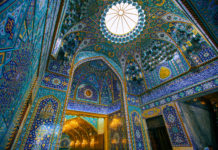Within the Imāmī-Shiʿi [1] Muslim tradition, the traditional institution of higher religious learning is commonly known as the ḥawzah ʿilmiyyah (“intellectual citadel”). Historically, the ḥawzah ʿilmiyyah was an advanced institution for the intellectual development of the Islamic sciences. Of course, the term “science” is to be understood here in the pre-modern sense of the Arabic term, ʿilm; a systematic body of knowledge as an object of study. This is in contrast to the modern—more restricted—usage of “science” as excluding any enterprise that does not involve testable predictions and explanations about some natural or social phenomenon.[2] A comprehensive survey of some of the major Islamic sciences from one prominent perspective within the ḥawzah is found in Understanding Islamic Sciences, published in 2002 by the London-based Islamic College for Advanced Studies (ICAS).
Understanding Islamic Sciences is a useful collection of articles, authored by the late Shahīd Murtaḍa Muṭahharī and translated into English by ICAS. Muṭahharī, an influential modern Shiʿi theologian and jurist, was one of the intellectual architects of the Islamic Republic of Iran, whose writings and lectures played an important role in the success of the Islamic revolution. He was martyred in 1979. Each article in Understanding Islamic Sciences introduces readers to a particular science studied in the ḥawzah ʿilmiyyah, expounds on and evaluates various theories in Islamic scholarship broadly, and serves as a guide to understanding Shiʿi Islam. Six sciences are explored in this text in the following order: philosophy (falsafah), theology (ʿilm al-kalām), mysticism (ʿirfān), jurisprudence (furūʿ al-fiqh), legal theory (uṣūl al-fiqh) and ethics (hikmah ʿamaliyyah).
The first two chapters of Understanding Islamic Sciences introduce readers to the closely-related sciences of falsafah and ʿilm al-kalām. Muṭahharī defines the latter as a science that dialectically identifies, establishes (rationally or textually), and defends Islamic doctrine.[3] The former may be defined in the following two ways: In classical general usage, falsafah did not designate a particular science but all non-textually transmitted (ʿaqlī) sciences attained through human intellect, such as metaphysics, pure mathematics, and the natural sciences. However, due to the influence of modernism, Muṭahharī notes that the term narrowed to “non-scientific” intellectual disciplines (i.e., ontology).[4] Second, in classical technical usage, falsafah referred to the specific discipline of metaphysics (al-falsafah al-ūlā), that is, “a science of the states of being from the standpoint of being.”[5] This narrower reference renders problematic the common translation of falsafah into the much broader English term “philosophy” as the latter is neither restricted to nor even necessarily cognizant of metaphysics proper. Moreover, philosophical inquiry in the Islamic scholastic realm was certainly not restricted to those who belonged to the particular schools of falsafah mentioned below.[6]
Advocates of falsafah in the technical sense of the term gradually formed into competing schools of thought that were greatly influenced by certain trends within the Hellenistic philosophical tradition. In particular, the Peripatetic school associated with Ibn Sīnā, the Illuminationist school associated with Suhrawardī, and the School of Mullā Ṣadrā are elucidated by our author. Muṭahharī briefly discusses these major schools of falsafah, defends the Ṣadrian tradition (al-hikmah al-mutaʿāliyah), and promotes at length its solutions to various philosophical problems. These schools of falsafah were typically repudiated by scholars of ʿilm al-kalām in its early stages. Yet, due to the significant contributions to ʿilm al-kalām by the thirteenth-century Shiʿi philosopher and theologian, Naṣīr al-Dīn al-Tūsī, Muṭahharī notes that most of the discourse of this science subsequently took on a more philosophical tone.[7] Throughout the second chapter Muṭahharī neatly discusses the origins and theological stances of various schools of theology that arose in Islamic scholastic circles, especially the Ashʿarī, Muʿtazilī, and Imāmī schools. In addition to defending the latter, our author also briefly traces the foundations of ʿilm al-kalām to the words and actions of the imams of the Ahl al-Bayt (ʿa), in contradistinction to the orientalist tendency of presenting the discipline as essentially foreign to Islam.[8]
The third chapter of Understanding Islamic Sciences deals with the science of ʿirfān, which our author divides into theoretical and practical ʿirfān. The latter is regarded as a primarily normative inquiry that aims to positively develop man’s relationship to himself, the world, and God.[9] Theoretical ʿirfān is a primarily descriptive inquiry that seeks to understand God, the world, and oneself through mystical intuition, unlike the solely ratiocinative methods of falsafah in the classical technical sense of the term.[10] At first glance, there does not seem to be any meaningful distinction between practical ʿirfān and the study of ethics. Muṭahharī however insists that practical ʿirfān ought to be rigorously distinguished by its primal concern with the relationship between oneself and God, dynamic methodology of spiritual progression, and personal profundity.[11] Much of the chapter examines the origins, mystical stations, and terminology of the discipline, and the chapter provides many brief biographies of the prominent practitioners of ʿirfān and sufism. Our author also elucidates major opinions among the Shiʿi learned on the very validity of ʿirfān as a genuinely Islamic science, basically upholding its validity as long as one critically examines its content to ensure that it is consistent with Islamic orthodoxy.[12]
Furūʿ al-fiqh and uṣūl al-fiqh are the focus of the fourth and fifth chapters of Understanding Islamic Sciences. In the terminology of the Qurʾan and hadith literature, Muṭahharī notes that fiqh is a profound and extensive understanding of Islam with no special emphasis on a certain branch of Islamic scholarship. Gradually, fiqh became associated specifically with the legal dimension of Islam. The reason underlying this shift to a narrower definition of fiqh is an intriguing object of research—Muṭahharī speculates that the particular association between fiqh and the legal dimension of Islam was due to the sheer amount of queries regarding the subject during the early centuries of Islamic scholarship.[13] He then carefully differentiates the two branches of this subject, furūʿ al-fiqh and uṣūl al-fiqh, from one another.[14] The former is the “study of secondary commands” or Islamic legal commands and principles regarded as general rules of action, whereas uṣūl al-fiqh is the study of the principles to be used in deducing such legal precepts from their appropriate sources. The greater portion of these chapters narrates the rich transnational history of the Imāmī legal tradition and its most notable jurists. Our author also briefly introduces the various branches of furūʿ al-fiqh and some of the major discussions of uṣūl al-fiqh.
The final article of Understanding Islamic Sciences is about hikmah ʿamaliyyah, translated as “Islamic Morality and Ethics.” Muṭahharī engages in a comprehensive treatment of certain complex matters, such as the nature of human beings in contrast to other animals, the nature of religiosity, and the relationship between religion and science. Readers will unfortunately not find a clear understanding of hikmah ʿamaliyyah and how this science differs from ʿilm al-akhlāq, which is also translated as “ethics” in this series.[15] Indeed, the final chapter strikes one as a mere extension of the first, centering on the conclusions of the practical aspect of falsafah.
It should be kept in mind that Understanding Islamic Sciences is not intended to introduce the disciplines of the ḥawzah in their entirety. So other important areas of inquiry, whether foundational subjects like classical Arabic syntax or more advanced subjects like Qurʾanic exegesis, are not expounded in much detail. Readers unfamiliar with the ḥawzah may not recognize the historical centrality of uṣūl al-fiqh and the arguments of competing perspectives within the institution over the validity of certain subjects and theories that are defended by our author. Understanding Islamic Sciences is a fruitful survey for the student of Shiʿi Islam, giving a deeper appreciation of some of the major sciences studied in the ḥawzah. For the Imāmī-Shiʿi audience in particular, it provides a broader understanding of one’s own intellectual heritage and significant exposure to other Islamic schools of thought.
[1] “Imāmī” will be used synonymously with “Twelver” throughout this review.
[2] J.L. Heilbron, ed. The Oxford Companion to the History of Modern Science (NY: Oxford, 2003), vii.
[3] Murtaḍa Muṭahharī, Understanding Islamic Sciences (London: ICAS, 2002), 53.
[4] Ibid., 19-20.
[5] Ibid., 14.
[6] Seyyed Hossein Nasr, Traditional Islam in the Modern World (London: KPI, 1987), 184.
[7] Murtaḍa Muṭahharī, Understanding Islamic Sciences (London: ICAS, 2002), 72.
[8] Ibid., 77-78
[9] Ibid., 91.
[10] Ibid., 92.
[11] Ibid., 91-92.
[12] Ibid., 95.
[13] Ibid., 144.
[14] Ibid., 180-181.
[15] Ibid., 49.




